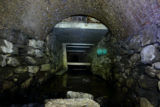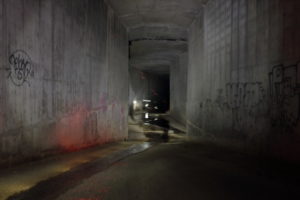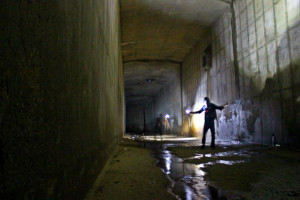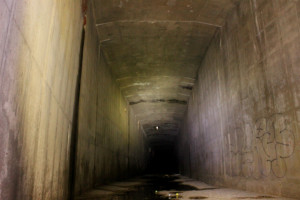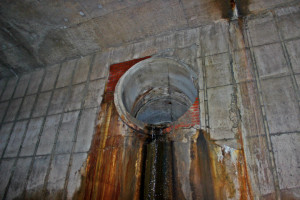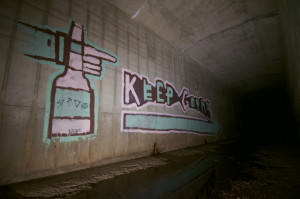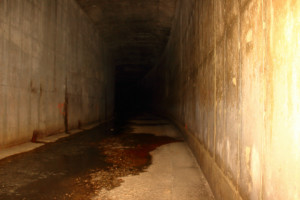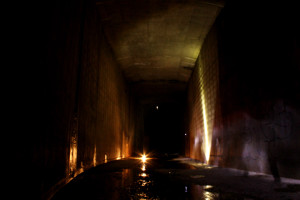
Early June, 2016
This find is truly an example of spontaneous Underground Urban Exploration at its finest. No more then 48 hours after everyone left out for the summer, I had a serious urge to get out exploring and grab some footage via my GoPro Hero+ and Canon T3i while doing it. I had woken up late in the day, taking advantage of the eerie silence that lay within my house that day and would continue for another 3 months. With no planning and 4 hours of daylight left to burn. I made a quick map research of the surrounding towns. Older is better I focused in on a old town that was not far from me. You know, one of those towns that if you blink its gone. What struck my interest is that a small creek disappeared more then what you expect it to disappear from the map. You know when a body of water gets covered when going under a road, there is a short distance (the width of the road) that it does not show up on the map. Well in this case it was much longer. I was suspicious that it was just a map error. Peering closely on the satellite imagery. Switching back and forth between Google and Bing’s birds eye view, I followed the creek as it winded down the slop and disappeared from view. I noticed that it disappeared into what looked like rocks. Yes, it seemed to be a hole surrounded by rocks. Not like a typical conduit style tunnel you see in newer tunnel construction. While the outfall of that tunnel was concrete conduit the intake was not. I thought it was worth the quick trip to check it out. Coffee to go, minimal gear, my newly acquired hard hat and I was out the door in a flash.
As I was nearing the area where this tunnel lays, I was paying close attention to the creek that would lead up to the inflow of the tunnel. Difficulties in visualizing the mouth was evident as the summer brush had already grown thick. Moving along the road at half the speed limit, I caught a glimpse at what looked like a hole surrounded by rocks. How could I of not seen this before. I mean I guess you really have to look and most of the time. Underground creek crossing under the road are non-remarkable. I pull up to where I am going to park. Convenient parking and all, directly across from the trail that I would be accessing the creek, this is just great. I traverse down the trail, past an abandoned house that sits on the creek, its like an whole playground here. Will definitely have to make a follow up trip granted its only 3 minutes from my house. How convenient.

I manage to cross the stream without eating too much mud and suddenly I am out in the clear. I am hunkered down for a few minutes as there is a walking trail that sits at elevation and I am down below at the creek. Its not like I am doing something wrong but people will get suspicious for anything in a small town. Coast is clear, I start rocking and rolling towards the entrance of a modern day conduit. I am suprised how large this conduit is granted the creek is really not that big. The sides of the creek show debris that sits a meter, a meter and a half higher then daily flow so I guess the 10 x 15 foot conduit is with good reason. Taking note of the graffiti free walls. Not long after I penetrate the tunnel, I can see that the modern conduit connects with an older section. There is a brick arch that wraps down meeting stone walls. When I get to this point, the tunnel almost veers to the right and I am struck dead in the face by an old bared window. A window I said, an underground window built right into the ceiling of the tunnel. There are moments of concern that I should ease up at shining my torch at the window, in case the residents would see me but I am intrigue at this thing. Peering further down into the tunnel it resembles an old mine. Wood timbers line the walls, the walls consist of hand laid stone. Smaller tunnels and cavities open up into the main tunnel which strikes me as century old storm drains. The brick arched ceiling convex, most likely where the road is. I can almost here the cars driving over top of it. There is one section that shows great wear and tear. Its where the modern conduit connects with the century old arched brick. A quick risk assessment concludes this is the most dangerous part of this tunnel, as it shows great instability, and my hard hat has already paid for itself. This is all just so wild.
During all this, I am seeing these huge insects flying around that there. By no exaggeration, these insects are as big as a small bird. I get this sense that, its like another world back in there past the old forgotten window. There is a slight haze back in there but a steady stream of venture driven tunnel breath is blowing into my face and I think little of these monster insects and begin setting up my Canon T3i for some exposure shots. Exposure shots really put you in the heart of a scenario. You literally have to stand there next to the tripod and wait and wait and wait. Usually your senses are heightened, so its like I can hear something that I cant make out what it is. At one point I am sure its music, almost music box like. Another moment it sounds like laughter. I presume that the water lapping over the stones some how has created a laughter. The tunnel is laughing at me. I am fairly tripped out. I am not the type of explorer that enters these tunnels in search of haunted grounds. Out of all the sites I have explored, haunted and evilness is just not what I look for or expect.
Anyways, once this lengthy process of setting up for x10-15 , 30 second exposures, trying my hand at different aperture settings, is finished, I continue on with the idea that I will make it to the end of the tunnel. That is where the water dumps down into the tunnel. At this point the water is about 8 inches deep. I am suddenly overwhelmed by swarms of gnat like insects. They are attracted to my light and have literally engulfed my head. I shrug it off, swatting away. During all this those huge flying insects are flying circles around me, only momentarily visible in my lamps but completely audible as their massive wings are vibrating the air. Submerged stones make the trek futher treacherous. Just as I get to the point where a wooden beam stretches across the tunnel width, I cannot take it anymore. The gnats are so heavy they are going up in my nose, mouth and ears. My senses are literally inundated and its almost all reflex at this point. Combining the blanketing swarm, with the massive flying insects, entering my no fly zones. I decide to abort. I high tail it out of there, disregarding eloquent foot placement and just slosh my way out. The swarm lessened the nearer I drew closer to the entrance.
Due to its accessibility, subsequent explorations were had here. One of them focusing one the old storm drain that was accessed via a modern 92 inch concrete pipe. No more then 20 meters into this pipe you enter an original storm drain that is built from rock. Heavy repairs are evident in the ceilings and notably what looks to be a plug in the wall. The explorer did not venture further then 10-15 meters deep into this section. Partly due to this exploration being done solo / without a buddy system and also because with further survey of the area, this old storm drain leads no further then a dead end with a metal grate 50 meters away on the side of the road.
With further research and surveying the area, I have pinpointed exactly what house is built into the tunnel. I would love to speak with the owner to get a view of the window from the inside looking out but until then. The window will remain a mystery, and will hopefully be preserved for future generations to view. As its truly a unique gem buried within the rocks.
